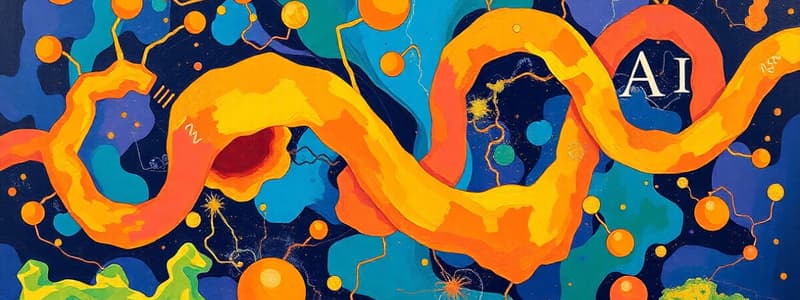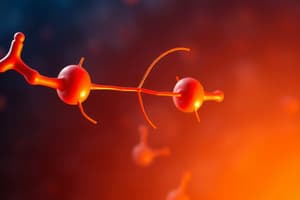Podcast
Questions and Answers
What characterizes two sugars as epimers?
What characterizes two sugars as epimers?
- They have the same molecular formula but different structural formulas.
- They differ in configuration around all carbon atoms.
- They differ in configuration around only one specific carbon atom. (correct)
- They are mirror images of each other.
What is the purpose of Molisch’s test?
What is the purpose of Molisch’s test?
- To identify the type of sugar present in a solution.
- To confirm the presence of carbohydrates in a solution. (correct)
- To confirm the presence of proteins in a solution.
- To confirm the presence of lipids in a solution.
Which of the following components is NOT part of the procedure for Molisch’s test?
Which of the following components is NOT part of the procedure for Molisch’s test?
- Amino acid solution (correct)
- 5% alpha-naphthol solution in ethyl alcohol
- Concentrated sulphuric acid
- A clean and dry test tube
What color indicates a positive result for Molisch’s test?
What color indicates a positive result for Molisch’s test?
Which statement best defines enantiomers in carbohydrate chemistry?
Which statement best defines enantiomers in carbohydrate chemistry?
Which compound is associated with the N-glycosidic linkage?
Which compound is associated with the N-glycosidic linkage?
Which group of substances does Molisch's test primarily identify?
Which group of substances does Molisch's test primarily identify?
Which of the following is true regarding the isomers mentioned in the content?
Which of the following is true regarding the isomers mentioned in the content?
What is measured in the hydrogen breath test after the patient consumes a lactose-loaded beverage?
What is measured in the hydrogen breath test after the patient consumes a lactose-loaded beverage?
What is the initial phase of glycolysis known for?
What is the initial phase of glycolysis known for?
Which of the following products is NOT produced during glycolysis?
Which of the following products is NOT produced during glycolysis?
What color indicates the presence of amylose during H. Bial's test?
What color indicates the presence of amylose during H. Bial's test?
What condition does the stool acidity test help assess in infants and children?
What condition does the stool acidity test help assess in infants and children?
What is the initial step in the procedure for Bial's test?
What is the initial step in the procedure for Bial's test?
Which carbohydrate bond is unlikely to be hydrolyzed during digestion?
Which carbohydrate bond is unlikely to be hydrolyzed during digestion?
Which component of starch is responsible for producing a purple color in Bial's test?
Which component of starch is responsible for producing a purple color in Bial's test?
What condition might lead to the symptoms of bloating, gas, and diarrhea described in the clinical case?
What condition might lead to the symptoms of bloating, gas, and diarrhea described in the clinical case?
What reaction occurs with furfural in the presence of ferric ion during Bial's test?
What reaction occurs with furfural in the presence of ferric ion during Bial's test?
How long does it typically take to obtain results from the hydrogen breath test?
How long does it typically take to obtain results from the hydrogen breath test?
Which sugar is specifically identified by the reaction producing violet or no color with iodine in Bial's test?
Which sugar is specifically identified by the reaction producing violet or no color with iodine in Bial's test?
During what process is hydrogen produced from undigested sugars?
During what process is hydrogen produced from undigested sugars?
What role do salivary and pancreatic alpha amylase play in carbohydrate metabolism?
What role do salivary and pancreatic alpha amylase play in carbohydrate metabolism?
How does glycogen appear when subjected to Bial's test?
How does glycogen appear when subjected to Bial's test?
What is the purpose of heating the test tube in Bial's test?
What is the purpose of heating the test tube in Bial's test?
What is the primary consequence of lactase deficiency in individuals?
What is the primary consequence of lactase deficiency in individuals?
Which glycosidic bond is specifically hydrolyzed by lactase?
Which glycosidic bond is specifically hydrolyzed by lactase?
What type of disorder is associated with sucrase-isomaltase deficiency?
What type of disorder is associated with sucrase-isomaltase deficiency?
What symptoms are commonly associated with lactose intolerance?
What symptoms are commonly associated with lactose intolerance?
Which enzyme is coded by the LCT gene?
Which enzyme is coded by the LCT gene?
What happens in the intestines when lactose is not broken down?
What happens in the intestines when lactose is not broken down?
What is the prevalence of individuals affected by sucrase-isomaltase deficiency?
What is the prevalence of individuals affected by sucrase-isomaltase deficiency?
Which catalytic site of the beta-glycosidase complex hydrolyzes the α-1,6 glycosidic bond?
Which catalytic site of the beta-glycosidase complex hydrolyzes the α-1,6 glycosidic bond?
What is the primary consequence of hexokinase deficiency in red blood cells?
What is the primary consequence of hexokinase deficiency in red blood cells?
Which of the following deficiencies is most commonly associated with glycolysis malfunction?
Which of the following deficiencies is most commonly associated with glycolysis malfunction?
What type of inheritance pattern is primarily associated with mutations affecting glycolytic enzymes?
What type of inheritance pattern is primarily associated with mutations affecting glycolytic enzymes?
What is the role of glucokinase in glucose metabolism?
What is the role of glucokinase in glucose metabolism?
Which diagnosis is commonly associated with hexokinase deficiency?
Which diagnosis is commonly associated with hexokinase deficiency?
Which enzyme is specifically known for converting acetaldehyde to ethanol?
Which enzyme is specifically known for converting acetaldehyde to ethanol?
What biochemical outcome is primarily caused by inactivating mutations of glucokinase?
What biochemical outcome is primarily caused by inactivating mutations of glucokinase?
Which condition is a direct result of hexokinase deficiency in pediatric patients?
Which condition is a direct result of hexokinase deficiency in pediatric patients?
Study Notes
Carbohydrate Linkages and Isomers
- Purines, aromatic rings, proteins, and lipids are non-carbohydrate molecules linked to sugars.
- Isomers include glucose and fructose; they differ structurally but share the same molecular formula.
- Epimers, a specific type of isomer, differ at only one carbon atom, such as glucose and galactose.
Tests for Carbohydrates
-
Molisch’s Test:
- Confirms the presence of carbohydrates using a reagent of 5% alpha-naphthol in ethyl alcohol.
- Procedure: Combine CHO solution with Molisch reagent and add concentrated sulfuric acid. A purple ring indicates a positive result.
-
Bial’s Test:
- Distinguishes pentoses from hexoses by forming a blue-green complex with furfural in the presence of orcinol and ferric ion.
- Procedure: Heat Bial’s reagent with the test solution. A blue-green color indicates a positive result.
Enzyme Function and Disorders
-
Salivary and pancreatic alpha-amylase initiate the breakdown of polysaccharides.
-
Lactase Deficiency:
- Causes lactose intolerance (pain, gas, nausea) due to insufficient lactase enzyme.
- Genetic basis linked to LCT gene mutations affects lactose breakdown.
-
Sucrase-Isomaltase Deficiency:
- Autosomal-recessive disorder affecting 1 in 5,000 individuals; leads to abdominal pain and gas from undigested sugars.
- Diagnosis may include hydrogen breath tests that evaluate hydrogen levels from bacterial fermentation of lactose.
Glycolysis
- Glycolysis occurs in two stages: an energy-investment phase (first five steps) and an energy-generation phase (last five steps).
- End products of glycolysis include 2 pyruvate, 2 ATP, and 2 NADH.
- Hexokinase is known as HK4, acting as a glucose sensor critical in blood glucose regulation.
Malfunctions in Glycolysis
- Genetic mutations can disrupt glycolysis, leading to enzyme deficiencies such as phosphofructokinase, aldolase, enolase, and pyruvate kinase deficiencies.
- Hexokinase Deficiency:
- Results in hereditary non-spherocytic hemolytic anemia, particularly in pediatric patients due to poor oxygen delivery to tissues.
- Diagnosis includes increased levels of lactate dehydrogenase (LDH).
Clinical Case Insights
- Symptoms of lactase deficiency include abdominal issues, flatulence, and diarrhea.
- Symptoms suggest possible lactose intolerance or malabsorption, warranting further investigation through stool acidity tests or hydrogen breath tests.
Studying That Suits You
Use AI to generate personalized quizzes and flashcards to suit your learning preferences.
Related Documents
Description
Explore the fascinating world of carbohydrates, including their linkages, isomers like glucose and fructose, and important tests such as Molisch’s and Bial’s tests. Additionally, discover the role of enzymes in carbohydrate breakdown and related disorders. This quiz covers essential biochemical concepts you need to know.



